Do it by yourself. Answers may vary. A sample deep drawing is shown below.
The chapter Boxes And Sketches focuses on net of three-dimensional shapes. It helps the students to understand how two-dimensional shapes look when folded into three-dimensional structures. It covers the topics: philosophy3-D Shapes philosophyFaces of the given 3-D shapes philosophyAreas of 3-D Shapes NCERT Math-Magic questions are answered in a simple and engaging manner. We have also related 'Learning Concepts and interactive worksheets with the solutions. Our 'Learning Beyond' segment caters to all the probable questions that a child might think out of curiosity. Download Chapter 7 Boxes amd Sketches in PDF format for free here.
The NCERT Solutions for Maths Class 5 Chapter 9 - Boxes And Sketches are tailored to help the students master the concepts that are key to success in their classrooms. The solutions given in the PDF are developed by experts and correlate with the CBSE syllabus of 2025-2026. These solutions provide thorough explanations with a step-by-step approach to solving problems. Students can easily get a hold of the subject and learn the basics with a deeper understanding. Additionally, they can practice better, be confident, and perform well in their examinations with the support of this PDF.
Download PDF
Students can access the NCERT Solutions for Maths Class 5 Chapter 9 - Boxes And Sketches. Curated by experts according to the CBSE syllabus for 2025–2026, these step-by-step solutions make Maths much easier to understand and learn for the students. These solutions can be used in practice by students to attain skills in solving problems, reinforce important learning objectives, and be well-prepared for tests.
Make a deep drawing of a box which looks like this.
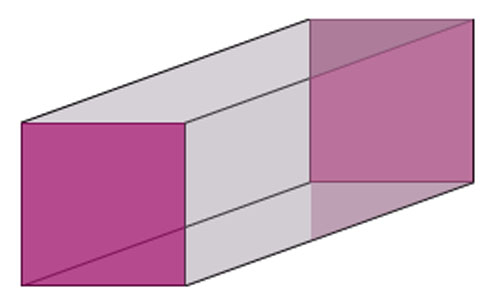
Do it by yourself. Answers may vary. A sample deep drawing is shown below.

All boxes are not cubes. Here are some different kinds of boxes. Match each shape below with a box into which it will fold

The correct answer is:

Make a matchbox model which looks like this.
Also make a deep drawing of the model in your notebook.

Do it by yourself.
Look at the photo and try to make a deep drawing of this bridge.
The correct answer is:

Look at this floor map of a house. Make doors and windows on the deep drawing of this house.
Are there any windows you couldn’t show on the deep drawing? Circle them on the floor map.

Observe the given floor map and draw doors and windows accordingly in the deep drawing of the house. The correct answer is:

In the deep drawing, there are two windows that are not visible. These windows are circled on the following floor map.

Ramya went to buy sweets. The shopkeeper took a paper cut-out and quickly made a lovely pink box for the sweets!
She made four more shapes. Each is to be folded along the dotted lines. You have to find out which of these can be made into a box.

Observe the given shapes. After folding along the given dotted lines, the shapes a) and (c) can be made into boxes.
Navin, Bhaskar and Pratigya made this bridge using matchboxes.

If you look at the bridge from the top, how will it look? Choose the right drawing below:
a)![]()
b)
The top view of the bridge is:

This cut-out is folded to make a cube.

Which of these are the correct deep drawings of that cube?
a)
b)
c)
d)
e)
The correct deep drawings are a) d), and e).

Soumitro and his friends made deep drawings of a cube. These are their drawings.
a)
b)
c)
d)
e)
f)
g)
A) Which of the drawings look correct to you? Discuss.
B) Can you add some lines to make drawing (f) into a deep drawing of the cube?
A) A cube has 6 faces, and each face of a cube is a square. Therefore, the drawings (d) and (e) are correct.
B) The (f) that has been made into a cube by drawing some lines is shown below:


A) How many cubes are needed to make this interesting model?
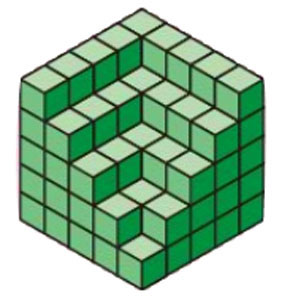
B) Here are some drawings of the model. Mark the correct top view drawing with ‘T’ and the correct side view drawing with ‘S’


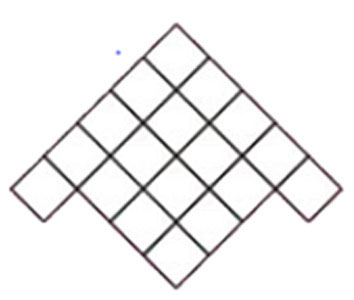

A) Observe the given model.
In the top layer, there are:
4 + 5 = 9 cubes.
In the second layer from the top, there are:
4 + 5 + 3 + 4 = 16 cubes
In the third layer from the top, there are:
4 + 5 + 3 + 4 + 2 + 3 = 21 cubes
In the fourth layer from the top, there are:
4 + 5 + 3 + 4 + 2 + 3 + 2 + 1 = 24 cubes
In the bottom layer, there are:
4 + 5 + 3 + 4 + 2 + 3 + 2 + 1 + 1 + 1 = 25 cubes
Therefore, total number of cubes in the model is:
9 + 16 + 21 + 24 + 25 = 95
Hence, 95 cubes are needed to make the given model.
B) The correct answer is:

For making a house a floor map is first made. Have you ever seen a floor map? Here is a floor map of Vibha’s house. It shows where the windows and the doors are in the house.
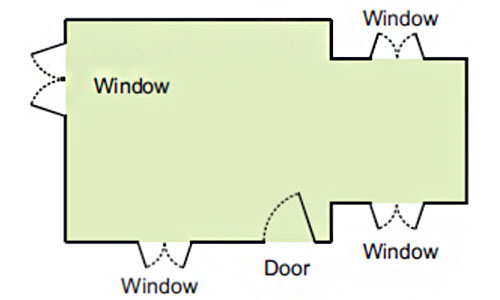
B) Which is the front side of her house? How many windows are there on the front side?
C) Which one is Vibha’s house?

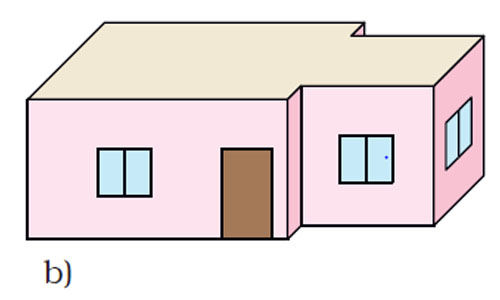

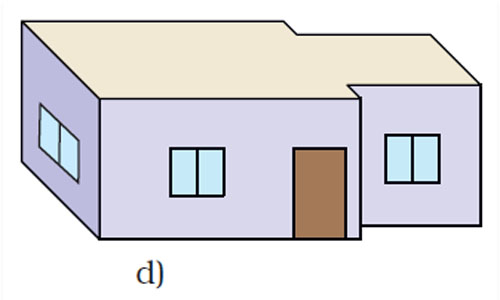
A) Do it by yourself. Answers may vary.
B)Front side of the house is shown below in the floor map. There are two windows on the front side.

3) Match the deep drawings with the given floor map. The correct deep drawing of the house is option c).

Buddha wants to make a paper cube using a squared sheet. He knows that all the faces of a cube are squares. He draws two different shapes.
a) Will both of these shapes fold into a cube?
b) Draw at least one more shape which can fold into a cube.
c) What will be the area of each face of the cube?
d) Draw one shape which will not fold into a cube.
e) Look around and discuss which things around you look like a cube. List a few.

a) A cube has four square shaped faces. Observe the given shapes. Both the shapes can be folded into cubes.
b) Answers may vary. Following is a shape that can be folded into a cube.

c) Each face of the cube is a square with 1 cm as its side. Therefore, the area of each face of the cube will be 1 square cm.
d) Answers may vary. Following is a shape that cannot be folded into a cube.

e) Do it by yourself. Answers may vary. The shape of dice, sugar cubes, ice cubes, etc., resembles a cube.
Make drawings to show how this bridge will look:
• From the top • From the front • From the side

The top view of the bridge is:

The front view of the bridge is:

The side view of the bridge is:
